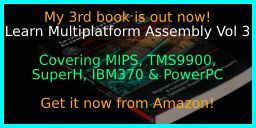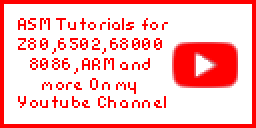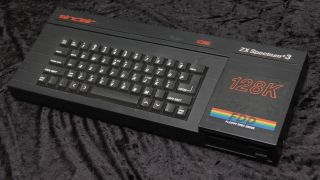

Z80 Assembly programming for the ZX Spectrum
|
The Keyboard
We can read in a row of the keyboard by setting BC to the correct value and using IN A,(C)... the resulting byte will contain a 0 if the key is pressed, 1 if it is not.
| C= &FE | |||||
| B=... |
4 |
3 |
2 |
1 |
0 |
| %11111110 | V | C | X | Z | SHIFT |
| %11111101 | G | F | D | S | A |
| %11111011 | T | R | E | W | Q |
| %11110111 | 5 | 4 | 3 | 2 | 1 |
| %11101111 | 6 | 7 | 8 | 9 | 0 |
| %11011111 | Y | U | I | O | P |
| %10111111 | H | J | K | L | ENTER |
| %01111111 | B | N | M | SYMB | SPC |
AY-3-8910 Sound Chip:
| Register | Meaning | Bit Meaning | Details |
| 0 | Tone Pitch L - Channel A | LLLLLLLL | Lower value = Higher pitch |
| 1 | Tone Pitch H - Channel A | ----HHHH | Lower value = Higher pitch |
| 2 | Tone Pitch L - Channel B | LLLLLLLL | Lower value = Higher pitch |
| 3 | Tone Pitch H - Channel B | ----HHHH | Lower value = Higher pitch |
| 4 | Tone Pitch L - Channel C | LLLLLLLL | Lower value = Higher pitch |
| 5 | Tone Pitch H - Channel C | ----HHHH | Lower value = Higher pitch |
| 6 | Noise Generator | ---NNNNN | Higer = Faster noise |
| 7 | Mixer | --NNNTTT | N=Noise T=Tone (Channel --CBACBA 1=mute 0=normal) |
| 8 | Amplitude - Channel A | ---EVVVV | E=Envelope (1=Enabled) VVVV=Volume |
| 9 | Amplitude - Channel B | ---EVVVV | E=Envelope (1=Enabled) VVVV=Volume |
| 10 | Amplitude - Channel C | ---EVVVV | E=Envelope (1=Enabled) VVVV=Volume |
| 11 | Envelope L (Volume over time) | LLLLLLLL | Lower=Faster Envelope |
| 12 | Envelope H (Volume over time) | HHHHHHHH | Lower=Faster Envelope |
| 13 | Envelope Selection | ----EEEE | Envelope number (See PDF) |
Beeper Sound Chip:
| The "Beeper" sound chip is incredibly crude... it is controlled by
bit 5 of the port &FE... by turning it on and off we can make
simple sounds... See the example to the right... by changing the pause (caused by BC) we can change the pitch of the sound... 3000 will be a relatively low pitch... 500 will be higher... Some clever programs even manage to "Fake" multiple sound channels! The big disadvantage to all this is that the CPU will be busy during the whole time, so the Beeper chip isn't very helpful, and we'll want to use the AY sound chip on the 128k systems... but on the 48k machines, it's all we've got! |
xor a loopy: xor %00010000 ;---S-BBB S=Sound B=Border out (&fe),a ld bc,3000 ;Lower number=higher pitch pausey: dec c jr nz,pausey dec b jr nz,pausey jr loopy |
Ram Banking
Ram banking is controlled by port &7FFD and &1FFD - they can be written, but not read, therefore, you should keep a backup of the value last sent to this port... by default the firmware keeps one at &5B5C and &5B67
| Port | Backup | Bits | Details |
| &7FFD | &5B5C | - - IRSMMM | MMM= ram bank at C000 (0-7) S=Screen page bit R=Rom Low bit I=I/O Disabling |
| &1FFD | &5B67 | - - - SDR - P | P = paging mode (0=normal 1=+3) R=Rom high bit D = Disk Motor S=Printer strobe |
The ZX Spectrum 128 has 4 banks of 16k, the first is always rom on the 128k... the +3 CAN have ram in this bank, but this will mean you cannot support the 128k system (only about 15% of spectrums on the market are +3's)
Note... the Black +2 has the same hardware as the +3... the Grey +2 has the same hardware as the spectrum128 system
| ZX 128K | |
| &0000 | ROM |
| &4000 | Screen 1 (5)* |
| &8000 | Ram (2) |
| &C000 | Screen 2 (7) |
Ram Contention
'Contention' is banks of memory which are slower due to sharing with the screen memory, unfortunately, the banks that are contended are different on the 128k machines and the +3
| 128K | +3 |
| Ram 0 | Ram 0 |
| Ram 1 | Ram 1 |
| Ram 3 | Ram 3 |
| Ram 4 | Ram 4 |
| Ram 6 | Ram 6 |
| Dark=Contended |
Spectrum +3 Ram Options
As Mentioned, the spectrum +3 has some special banking options, which were used to allow CPM to work on the Spectrum - they are enabled by setting bit 0 of &1FFD to '1' to turn on this special mode
| &1FFD Bits 2,1 | ||||
| 00 | 01 | 10 | 11 | |
| &C000 | Bank 3 | Bank 7 | Bank 3 | Bank 3 |
| &8000 | Bank 2 | Bank 6 | Bank 6 | Bank 6 |
| &4000 | Bank 1 | Bank 5 (S) | Bank 5 (S) | Bank 7 (S) |
| &0000 | Bank 0 | Bank 4 | Bank 4 | Bank 4 |
| S=Screen Bank | ||||
Memory Map
| 48k | Usage |
|
| 0000 | 3FFF | ROM |
| 4000 | 57FF | Screen Ram |
| 5800 | 5AFF | Screen Ram Color Data |
| 5B00 | 5BFF | Printer Buffer (Sysvars on +3) |
| 5C00 | 5CBF | System Vars |
| 5CC0 | 5CCA | Reserved |
| 5CCA | 5D3B | TR-DOS Area |
| 5D3B | FF57 | Available Memory (Between Prog and Ramtop |
| FF58 | FFFF | Reserved (User defined characters) |
Screen Map
Calculating screen addresses for bitmap pixel data can be performed with the following 'formula'
| H | L | |||||||||||||||
| 7 | 6 | 5 | 4 | 3 | 2 | 1 | 0 | 7 | 6 | 5 | 4 | 3 | 2 | 1 | 0 | |
| 0 | 1 | 0 | Y7 | Y6 | Y2 | Y1 | Y0 | Y5 | Y4 | Y3 | X4 | X3 | X2 | X1 | X0 | |
Calculating screen addresses for color block data can be performed with the following 'formula'
| H | L | |||||||||||||||
| 7 | 6 | 5 | 4 | 3 | 2 | 1 | 0 | 7 | 6 | 5 | 4 | 3 | 2 | 1 | 0 | |
| 0 | 1 | 0 | 1 | 1 | 0 | Y7 | Y6 | Y5 | Y4 | Y3 | X4 | X3 | X2 | X1 | X0 | |
A HL Pixel address (&4000-&57FF) can be converted to a color address (&5800-&5AFF) with the following commands:
ld a,h ;HL
is a pixel address
srl a
srl a
srl a
add &50
ld h,a ;Address is now the
equivalent color address
Each Color byte is defined in the following format:
| % | 7 | 6 | 5 | 4 | 3 | 2 | 1 | 0 |
| Flash | Bright | Back | Back | Back | Fore | Fore | Fore |
FOREground and BACKground colors are defined by 3 bits each... values from 0-7:
| 0 | 1 | 2 | 3 | 4 | 5 | 6 | 7 |
| Black #000000 |
Blue #0000FF |
Red #FF0000 |
Magenta #FF00FF |
Green #00FF00 |
Cyan #00FFFF |
Yellow #FFFF00 |
White #FFFFFF |
Spectrum +3 Disk File Header
| Position | Bytes | Content | Details | Example |
| &0000 | 8 | PLUS3DOS | Text Header | PLUS3DOS |
| &0009 | 1 | EOF byte | EOF Character | 26 |
| &000A | 1 | Issue Num | Issue Num | 1 |
| &000B | 1 | Version Num | Version Num | 0 |
| &000F | 4 | Size+128 | Size INC Header | &1080 |
| &0010 | 2 | Size | Size of file | &1000 |
| &0012 | 5 | Basic Header | Basic Header | &03,&00,&80,&00,&80 |
| &0017 | 104 | Unused | Unused | 0 0 0 0� |
| &007F | 1 | Checksum | Checksum of Header bytes 0-126 (MOD 256) | ? |
| &0080 | Program Code | |||
Spectrum Links
Spectrum 128k and Spectrum 48K reference - Great summary of the hardware - provides much of the info you'll want for ZX dev
Basic Manual - You'll want to know at least enough basic to do calls and operate the computer
Spectrum Computing Forum - Web community full of helpful people!
General Z80 Assembly Tutorials:
B. Beginner series - Learn the basics
A. Advanced series - In more detail
M. Multiplatform series - programming methods that work on all systems
| View Options |
| Default Dark |
| Simple (Hide this menu) |
| Print Mode (white background) |
| Top Menu |
| ***Main Menu*** |
| Youtube channel |
| Patreon |
| Introduction to Assembly (Basics for absolute beginners) |
| Amazon Affiliate Link |
| AkuSprite Editor |
| ChibiTracker |
| Dec/Bin/Hex/Oct/Ascii Table |
| Alt Tech |
| Archive.org |
| Bitchute |
| Odysee |
| Rumble |
| DailyMotion |
| Please note: I wlll upload more content to these alt platforms based on the views they bring in |
| 68000 Content |
| ***68000 Tutorial List*** |
| Learn 68000 Assembly |
| Hello World Series |
| Platform Specific Series |
| Simple Samples |
| Grime 68000 |
| 68000 Downloads |
| 68000 Cheatsheet |
| Sources.7z |
| DevTools kit |
| 68000 Platforms |
| Amiga 500 |
| Atari ST |
| Neo Geo |
| Sega Genesis / Mega Drive |
| Sinclair QL |
| X68000 (Sharp x68k) |
| 8086 Content |
| Learn 8086 Assembly |
| Platform Specific Series |
| Hello World Series |
| Simple Samples |
| 8086 Downloads |
| 8086 Cheatsheet |
| Sources.7z |
| DevTools kit |
| 8086 Platforms |
| Wonderswan |
| MsDos |
| ARM Content |
| Learn ARM Assembly |
| Learn ARM Thumb Assembly |
| Platform Specific Series |
| Hello World |
| Simple Samples |
| ARM Downloads |
| ARM Cheatsheet |
| Sources.7z |
| DevTools kit |
| ARM Platforms |
| Gameboy Advance |
| Nintendo DS |
| Risc Os |
| Risc-V Content |
| Learn Risc-V Assembly |
| Risc-V Downloads |
| Risc-V Cheatsheet |
| Sources.7z |
| DevTools kit |
| MIPS Content |
| Learn Risc-V Assembly |
| Platform Specific Series |
| Hello World |
| Simple Samples |
| MIPS Downloads |
| MIPS Cheatsheet |
| Sources.7z |
| DevTools kit |
| MIPS Platforms |
| Playstation |
| N64 |
| PDP-11 Content |
| Learn PDP-11 Assembly |
| Platform Specific Series |
| Simple Samples |
| PDP-11 Downloads |
| PDP-11 Cheatsheet |
| Sources.7z |
| DevTools kit |
| PDP-11 Platforms |
| PDP-11 |
| UKNC |
| TMS9900 Content |
| Learn TMS9900 Assembly |
| Platform Specific Series |
| Hello World |
| TMS9900 Downloads |
| TMS9900 Cheatsheet |
| Sources.7z |
| DevTools kit |
| TMS9900 Platforms |
| Ti 99 |
| 6809 Content |
| Learn 6809 Assembly |
| Learn 6309 Assembly |
| Platform Specific Series |
| Hello World Series |
| Simple Samples |
| 6809 Downloads |
| 6809/6309 Cheatsheet |
| Sources.7z |
| DevTools kit |
| 6809 Platforms |
| Dragon 32/Tandy Coco |
| Fujitsu FM7 |
| TRS-80 Coco 3 |
| Vectrex |
| 65816 Content |
| Learn 65816 Assembly |
| Hello World |
| Simple Samples |
| 65816 Downloads |
| 65816 Cheatsheet |
| Sources.7z |
| DevTools kit |
| 65816 Platforms |
| SNES |
| eZ80 Content |
| Learn eZ80 Assembly |
| Platform Specific Series |
| eZ80 Downloads |
| eZ80 Cheatsheet |
| Sources.7z |
| DevTools kit |
| eZ80 Platforms |
| Ti84 PCE |
| IBM370 Content |
| Learn IBM370 Assembly |
| Simple Samples |
| IBM370 Downloads |
| IBM370 Cheatsheet |
| Sources.7z |
| DevTools kit |
| Super-H Content |
| Learn SH2 Assembly |
| Hello World Series |
| Simple Samples |
| SH2 Downloads |
| SH2 Cheatsheet |
| Sources.7z |
| DevTools kit |
| SH2 Platforms |
| 32x |
| Saturn |
| PowerPC Content |
| Learn PowerPC Assembly |
| Hello World Series |
| Simple Samples |
| PowerPC Downloads |
| PowerPC Cheatsheet |
| Sources.7z |
| DevTools kit |
| PowerPC Platforms |
| Gamecube |
| Work in Progress |
| ChibiAndroids |
| Misc bits |
| Ruby programming |
Buy my Assembly programming book
on Amazon in Print or Kindle!



Available worldwide!
Search 'ChibiAkumas' on
your local Amazon website!
Click here for more info!


Buy my Assembly programming book
on Amazon in Print or Kindle!



Available worldwide!
Search 'ChibiAkumas' on
your local Amazon website!
Click here for more info!


Buy my Assembly programming book
on Amazon in Print or Kindle!



Available worldwide!
Search 'ChibiAkumas' on
your local Amazon website!
Click here for more info!





